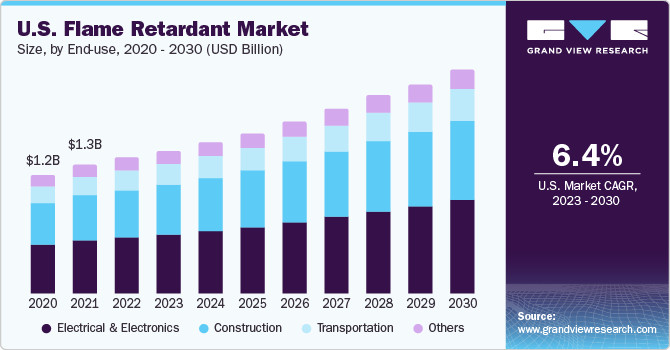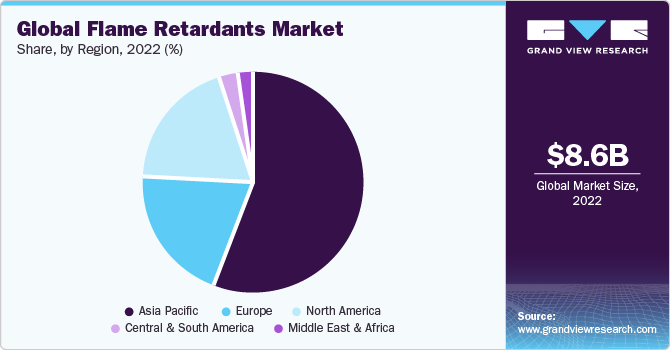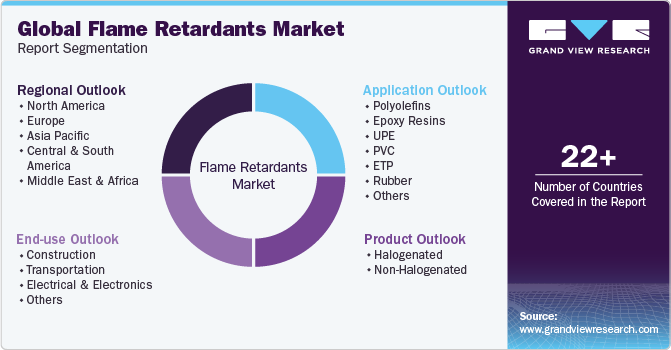- Home
- »
- Plastics, Polymers & Resins
- »
-
Flame Retardant Market Size, Share & Growth Report, 2030GVR Report cover
![Flame Retardant Market Size, Share & Trends Report]()
Flame Retardant Market Size, Share & Trends Analysis By Product (Halogenated, Non-halogenated), By Application (Polyolefin, Epoxy Resins), By End-use (Electrical & Electronics, Construction), By Region, And Segment Forecasts, 2023 - 2030
- Report ID: GVR-1-68038-281-5
- Number of Report Pages: 82
- Format: PDF, Horizon Databook
- Historical Range: 2018 - 2021
- Forecast Period: 2023 - 2030
- Industry: Bulk Chemicals
Flame Retardant Market Size & Trends
The global flame retardant market size was valued at USD 8.63 billion in 2022 and is anticipated to grow at a compound annual growth rate (CAGR) of 7.1% from 2023 to 2030. The demand for flame Retardants is anticipated to be driven by the growing usage of fire-resistant products in various end-use industries, such as electrical & electronics, transportation, construction, and others. These industries are increasingly using flame retardant-based materials to meet fire safety and prevention regulations. The product demand is also fueled by the growing awareness among consumers about improving the fire safety of combustible materials and products. In offices and homes, flame retardants eliminate the risk of fire from an increasing number of electrical and consumer goods.

They also safeguard modern equipment and materials, such as building insulation, engineering thermoplastics, circuit boards, cables, and others, from the ignition and spread of fire. The growth of halogenated flame retardants, such as chlorinated, brominated, and others, is significantly restrained by the harmful effects of the chemicals on humans and the environment. Certain compounds, such as Hexabromocyclododecane (HBCD), are banned in the European Union, Canada, and Japan.
This has majorly driven the market for the development of safer alternatives, such as phosphorous, bromine, and chlorine-based non-halogenated flame retardants. The shifting trend toward the replacement of halogenated flame retardants has mainly driven innovation for new non-halogenated products as it promotes environmental sustainability. For instance, GYC Group, a manufacturer of specialty chemicals and fire-resistance products, offers a wide range of halogen-free products.
Manufacturers look for fewer toxic products to make changes in the product composition, such as aluminum triohydroxide. It is expected that most of the demand will arise from applications, such as polyolefins, epoxy resins, Polyvinyl Chloride (PVC), engineering thermoplastics, rubber, and others. China, Iran, Italy, the U.K., the U.S., and France, are among the worst-hit economies due to the pandemic that resulted in industrial shutdowns, supply chain disruptions, and trade halts. This factor may hamper the market growth to some extent.
Product Insights
The non-halogenated segment accounted for the largest revenue share of 60.9% in 2022 is expected to grow at the fastest CAGR of 8.0% during the forecast period. This is attributed to the rising demand for environmentally friendly and less toxic flame retardants. A combination of antimony trioxide and brominated organic compounds is commonly used as flame retardants in mounding compounds, and they are known to have deleterious environmental effects.
Antimony trioxide when combined with hydromagnesite fillers offers advantageous flame retardant properties. However, the environmental effects of antimony trioxide are expected to propel the demand for environmentally friendly and safer alternatives, such as non-halogenated flame retardants, in the future.
Many of our daily objects incorporating engineered thermoplastic materials, such as textiles, household appliances, automobiles, and airplanes, are now being intensively examined for their flammability. The application of flame retardants is expected to increase as it plays a vital role in reducing the general risk of fire associated with the use of highly combustible feedstock in products, such as textiles, clothing, composites, and plastics.
Application Insights
The polyolefins segment accounted for the largest revenue share of around 26.6% in 2022 and is expected to grow at the fastest CAGR of 7.7% over the forecast period. This is due to the growing use of polyolefins as plastics in numerous applications. The product is added to polyolefins to reduce the spread of flame, prevent the polymer from dripping, and suppress smoke formation. Construction fabrics, mattress covers, roofing and siding, components in trains and planes, carpet backing, automotive fabrics, and others are a few examples of products that require flame retardants in polyolefin fabrics.
Polyvinyl chloride is the most widely used polymer, primarily in communication and electrical cables in insulation and domestic applications in window frames, doors, house sidings, and gutters. It has a high level of resistance to combustion. Although, PVC is not considered to be safe owing to smoke and toxic gases, such as benzene, chlorine compounds, and other aromatics.
It is attracting consumers’ attention because of its fire resistance nature. PVC, being a thermally unstable polymer, requires stabilization for processing. The higher level of “impact modifier” and “processing aid” addition to PVC imparts flame resistance to the formulation.
End-use Insights
The electrical & electronics segment held the largest revenue share of 38.3% in 2022. Its high share is attributed to an increased usage of the product in the plastic casing of electric products for consumer safety and to reduce the risk of fire. The construction end-use segment is another major segment, which accounted for 28.1% of the overall revenue share in 2020. With the growing construction industry and rising awareness regarding the importance of fire protection, the demand for fire retardants is anticipated to increase over the forecast period.
The construction segment is expected to grow at the fastest CAGR of 9.2% over the forecast period, owing to a growing awareness of fire hazards and the importance of fire safety in the construction industry. Building owners, developers, and construction professionals are placing greater emphasis on incorporating flame retardant materials in the design and construction of buildings. The need to mitigate fire risks and ensure the safety of occupants drives the demand for flame retardants.
The rapidly developing transportation industry and the need to address fire safety in the automobile industry are expected to boost product demand. The rising environmental concerns are expected to propel the demand for halogen-free flame retardant products across various industries. Manufacturers are developing a wide range of products with different chemical compositions. For instance, ICL, a global manufacturer of unique products for agriculture, food, and engineering materials markets, manufactures more than 50 flame-retardant solutions for various applications in the transportation and automotive industries.
Regional Insights
Asia-Pacific dominated the market and accounted for the largest revenue share of 56.1% in 2022 and is expected to grow at the fastest CAGR of 7.7% during the forecast period. This is attributed to the stringent regulations regarding fire safety and high product demand from the end-use markets, such as automotive, electrical & electronics, construction, and others.
The production facilities in Asia Pacific account for a large share of the product market. The market is led by China and India. The market growth can also be attributed to the rising awareness about safety regulations and the ongoing infrastructure development projects in emerging economies, such as India, China, and Japan.

The major driver of the flame retardant industry in North America includes the rising demand for electrical components in numerous applications, such as power cables, wiring, and connectors, mainly used in building, transportation, and electronic devices. The U.S. dominates the North America regional market followed by Canada. This can be attributed to the large-scale production and the growing electrical & electronics, automotive, and construction sectors in the U.S. The growth in the automotive and construction sectors is witnessed due to increasing investments in EVs and private construction projects.
Key Companies & Market Share Insights
Key companies are constantly undertaking new initiatives to develop innovative products as an alternative to halogen-based flame retardants in an attempt to strengthen their position in the global market. The rising demand for halogen-free products is attracting new manufacturers to the market. The existing companies are entering into the manufacturing industry to gain significant market share against their competitors. An extensive product portfolio enables the manufacturers to meet the rising demand from new and existing customers.
Key Flame Retardant Companies:
- Albemarle Corporation
- ICL
- LANXESS
- CLARIANT
- Italmatch Chemicals S.p.A
- Huber Engineered Materials
- BASF SE
- THOR
- DSM
- FRX Innovations
- DuPont
Recent Development
-
In January 2022, Huber Engineered Materials successfully acquired MAGNIFIN Magnesiaprodukte GmbH & Co KG (MAGNIFIN). The product lineup previously presented by MAGNIFIN and represented by Martinswerk GmbH has seamlessly become an integral part of Huber's strategic business unit, Fire Retardant Additives (FRA). This strategic integration bolsters Huber's array of smoke suppressants, halogen-free fire retardants, and specialized aluminum oxides, significantly amplifying its worldwide market influence.
-
In December 2021, CLARIANT commenced the construction of a new flame retardant production facility at its established site in Daya Bay, Guangdong Province, China. The new facility will enhance production capacity and enable CLARIANT to better serve the growing demand for flame retardant solutions in the region.
-
In November 2021, Italmatch Chemicals SpA introduced a new phosphorous flame retardant called "Liquid Masteret." This innovative product includes concentrated blends of stabilized and micro-encapsulated Red Phosphorus (RP). This offering aligns with market needs and provides effective fire protection solutions in industries where halogen-free options are preferred.
Flame Retardant Market Report Scope
Report Attribute
Details
Market size value in 2023
USD 9.13 billion
Revenue forecast in 2030
USD 14.90 billion
Growth rate
CAGR of 7.1% from 2023 to 2030
Base year for estimation
2022
Historical data
2018 - 2021
Forecast period
2023 - 2030
Report updated
October 2023
Quantitative units
Revenue in USD million/billion, volume in kilo ton, and CAGR from 2023 to 2030
Report coverage
Revenue forecast, company ranking, competitive landscape, growth factors, and trends
Segments covered
Product, application, end-use, region
Regional scope
North America; Europe; Asia Pacific; Central & South America; MEA
Country scope
U.S.; Canada; Mexico; UK; Germany; France; Italy; Spain; Norway; China; Japan; India; South Korea; Brazil; Argentina; Saudi Arabia; South Africa
Key companies profiled
Albemarle Corporation; ICL; LANXESS; CLARIANT; Italmatch Chemicals S.p.A; Huber Engineered Materials; BASF SE; THOR; DSM; FRX Innovations; DuPont
Customization scope
Free report customization (equivalent up to 8 analyst’s working days) with purchase. Addition or alteration to country, regional & segment scope
Pricing and purchase options
Avail customized purchase options to meet your exact research needs. Explore purchase options
Global Flame Retardant Market Report Segmentation
This report forecasts revenue growth at global, regional, and country levels and provides an analysis of the latest industry trends in each of the sub-segments from 2018 to 2030. For this study, Grand View Research has segmented the global flame retardant market report based on product, application, end-use, and region:

-
Product Outlook (Revenue, USD Million; Volume, Kilo Tons, 2018 - 2030)
-
Halogenated
-
Brominated
-
Chlorinated Phosphates
-
Antimony Trioxide
-
Others
-
-
Non-Halogenated
-
Aluminum Hydroxide
-
Magnesium Dihydroxide
-
Phosphorus Based
-
Others
-
-
-
Application Outlook (Revenue, USD Million; Volume, Kilo Tons, 2018 - 2030)
-
Polyolefins
-
Epoxy Resins
-
UPE
-
PVC
-
ETP
-
Rubber
-
Styrenics
-
Others
-
-
End-use Outlook (Revenue, USD Million; Volume, Kilo Tons, 2018 - 2030)
-
Construction
-
Transportation
-
Electrical & Electronics
-
Others
-
-
Regional Outlook (Revenue, USD Million; Volume, Kilo Tons, 2018 - 2030)
-
North America
-
U.S.
-
Canada
-
Mexico
-
-
Europe
-
UK
-
Germany
-
France
-
Italy
-
Spain
-
Norway
-
-
Asia Pacific
-
China
-
Japan
-
India
-
South Korea
-
-
Central & South America
-
Brazil
-
Argentina
-
-
Middle East and Africa
-
Saudi Arabia
-
South Africa
-
-
Frequently Asked Questions About This Report
b. The global flame retardant market size was estimated at USD 8.63 billion in 2022 and is expected to reach USD 9.13 billion in 2023.
b. The global flame retardant market is expected to grow at a compound annual growth rate of 7.1% from 2023 to 2030 to reach USD 14.90 billion by 2030.
b. Asia Pacific dominated the flame retardant market with a share of 56.14% in 2022. This is attributable to favorable government regulations aimed at the prevention of fire hazards.
b. Some key players operating in the flame retardant market include Albemarle, BASF ICL, Chemtura, Clariant International Ltd., Italmatch Chemicals, Huber Engineered Materials, BASF, Thor Group Ltd., & DSM.
b. Key factors that are driving the flame retardant market growth include stringent regulations across regions that mandate the use of flame retardants across prominent end-use industries including construction, electronics, textile, automotive.
Share this report with your colleague or friend.
![gvr icn]()
NEED A CUSTOM REPORT?
We can customize every report - free of charge - including purchasing stand-alone sections or country-level reports, as well as offer affordable discounts for start-ups & universities. Contact us now
![Certified Icon]()
We are GDPR and CCPA compliant! Your transaction & personal information is safe and secure. For more details, please read our privacy policy.
We are committed towards customer satisfaction, and quality service.
"The quality of research they have done for us has been excellent."





